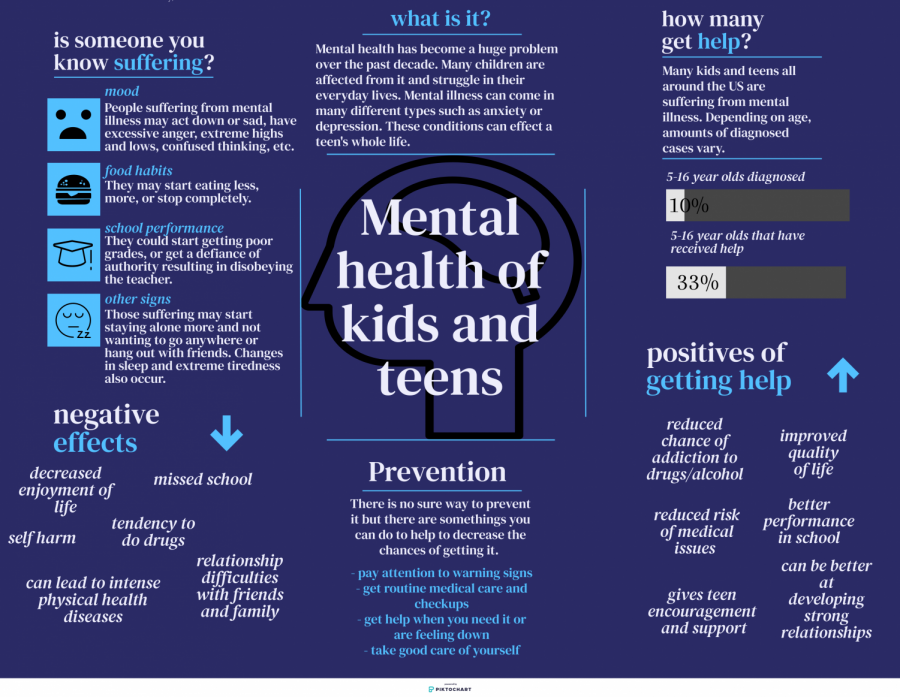Mental illness: a devastating epidemic
The massive amounts of mental health disorders in high schools
Each year, a large amount of kids and teens are affected by mental health issues. This number has increased majorly over the past decade. This info graphic shows the important information that should be known about mental health. It shows the symptoms, effects, prevention, and other facts about mental illness.
October 4, 2019
Over the past decade, the amount of teen suicides and other mental health issues have increased remarkably. According to The Association for Children’s Mental Health, 1 in 5 teens have a diagnosable emotional, behavioral or mental health disorder and 1 in 10 teens have an even more severe disorder that can affect how they act at home, school and in the community.
Half of all mental health disorders start at age 14 and encouragement of getting help for it is missing. On the report of Mental Health First Aid Today, 41% of all people that have mental health problems in the US actually get professional help. Putting more options in high schools to help those people would be an extremely useful start to fixing this growing problem in the US. A set of excused days for mental health and annual checkups on students, small breaks for students to de-stress and a number of other helpful plans would help prevent parts of this issue.
Suicide, depression and anxiety are aqccuired by students in a number of ways and many come from school itself.
The substantial amounts of work and homework assigned in school cause students an extensive amount of stress. The constant pressure and the time it takes to do the work has physical and mental effects on the teen. Schools need to be doing something to lessen this stress. Many students build up stress from worrying about grades, high school drama, after school activities, jobs, parents and other factors. As claimed by Oxford Learning, too much homework can lead to lack of sleep, headaches, exhaustion, weight loss and poor eating habits.
This constant pressure can lead to long-term mental and physical illness.
Symptoms of mental illness are visible and could be easy to look for. Inability to cope with stress or daily problems and trouble relating to and understanding others are indications of mental disease that teachers could identify and act on. They could also recognize changes in eating habits, significant tiredness or low energy and withdrawal from friends and activities.
As stated by The National Institution of Mental Health, routine stress, such as high school everyday for multiple years, can lead to severe disorders such as depression and anxiety. It can also bring serious physical health disorders such as heart disease, diabetes and high blood pressure.
Anxiety and depression can further affect the teen in a number of different ways. Ranging from factors that can affect their school success and career to their entire life. According to The Association of Children’s Mental Health, 50% of high school students with a mental disorder drop out before graduation. This is the highest dropout percent of any disability group. I would hope that administrators and other important people in the school communities would do anything to stop these negative effects. Mental disorders can also affect social life and how the teen interacts with other people. Those suffering may cut themselves off from society or start acting unusual. They may start talking to friends and family less or could want to stay home and never hang out with friends.
All types of mental disorders can cause life-changing effects. Many troubled by anxiety or depression resort to self harm which could affect them massively. Some even go to the extent of attempting to kill themselves. Recently, a teen in Omaha was found dead after attempted suicide. The consequences of anxiety, depression and stress alter the lives of the teen and all of the people around them.
High schools should be doing everything they can to prevent this.
Is is estimated that only 20% of all students with mental disorders get official help in or out of school. This needs to be fixed. Schools and councilors can inform teachers about symptoms of mental health issues and teach them what to do when they suspect a problem. They should also let students take mental health or stress days off that are excused. Therapy dogs that sense the stress or anxiety and get taken on annual checks around the school would also be helpful. One very important strategy to decreasing the issue is making a limit on how much homework students get, as homework is a leading factor in mental illness. All these ideas and more could help prevent some mental health cases.
Any student could be struggling with these problems but seem completely fine. Coming up with ways to fix this could help save a life. High schools need to start doing something.







